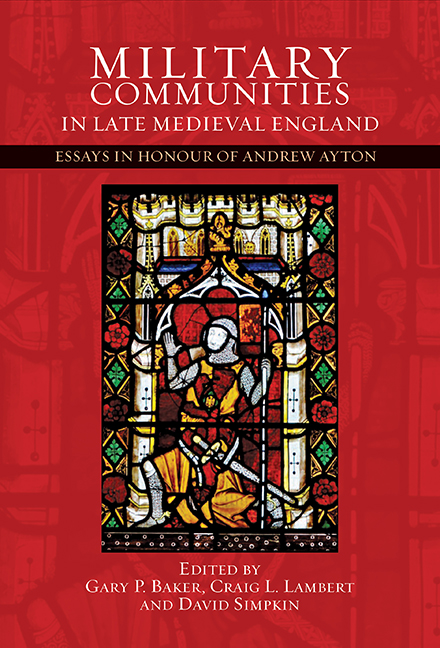Book contents
- Frontmatter
- Miscellaneous Frontmatter
- Contents
- List of Illustrations
- Acknowledgements
- List of Contributors
- Foreword
- Andrew Ayton: A Brief Tribute
- Andrew Ayton: A Recognition of his Work
- Abbreviations
- Part Title
- 1 ‘Big and Beautiful’. Destriers in Edward I's Armies
- 2 Cum Equis Discoopertis: The ‘Irish’ Hobelar in the English Armies of the Fourteenth Century
- 3 Andrew Ayton, the Military Community and the Evolution of the Gentry in Fourteenth-Century England
- 4 Knights Banneret, Military Recruitment and Social Status, c. 1270–c. 1420: A View from the Reign of Edward I
- 5 Sir Henry de Beaumont and His Retainers: The Dynamics of a Lord's Military Retinues and Affinity in Early Fourteenth-Century England
- 6 Financing the Dynamics of Recruitment: King, Earls and Government in Edwardian England, 1330–60
- 7 The Symbolic Meaning of Edward III's Garter Badge
- 8 Sir Robert Knolles’ Expedition to France in 1370: New Perspectives
- 9 The Organisation and Financing of English Expeditions to the Baltic during the Later Middle Ages
- 10 Naval Service and the Cinque Ports, 1322–1453
- 11 The Garrison Establishment in Lancastrian Normandy in 1436 according to Surviving Lists in Bibliothèque Nationale de France manuscrit français 25773
- Bibliography of the Writings of Andrew Ayton
- Index
- Tabula Gratulatoria
- Warfare in History
2 - Cum Equis Discoopertis: The ‘Irish’ Hobelar in the English Armies of the Fourteenth Century
from Part Title
Published online by Cambridge University Press: 17 July 2019
- Frontmatter
- Miscellaneous Frontmatter
- Contents
- List of Illustrations
- Acknowledgements
- List of Contributors
- Foreword
- Andrew Ayton: A Brief Tribute
- Andrew Ayton: A Recognition of his Work
- Abbreviations
- Part Title
- 1 ‘Big and Beautiful’. Destriers in Edward I's Armies
- 2 Cum Equis Discoopertis: The ‘Irish’ Hobelar in the English Armies of the Fourteenth Century
- 3 Andrew Ayton, the Military Community and the Evolution of the Gentry in Fourteenth-Century England
- 4 Knights Banneret, Military Recruitment and Social Status, c. 1270–c. 1420: A View from the Reign of Edward I
- 5 Sir Henry de Beaumont and His Retainers: The Dynamics of a Lord's Military Retinues and Affinity in Early Fourteenth-Century England
- 6 Financing the Dynamics of Recruitment: King, Earls and Government in Edwardian England, 1330–60
- 7 The Symbolic Meaning of Edward III's Garter Badge
- 8 Sir Robert Knolles’ Expedition to France in 1370: New Perspectives
- 9 The Organisation and Financing of English Expeditions to the Baltic during the Later Middle Ages
- 10 Naval Service and the Cinque Ports, 1322–1453
- 11 The Garrison Establishment in Lancastrian Normandy in 1436 according to Surviving Lists in Bibliothèque Nationale de France manuscrit français 25773
- Bibliography of the Writings of Andrew Ayton
- Index
- Tabula Gratulatoria
- Warfare in History
Summary
The hobelar is very much the poor relation in the study of the English armies of the fourteenth century, eclipsed by both the man-at-arms and the archer. Our understanding of his origins and role has been wholly based on only two major studies of this troop type: J. E. Morris’ ‘Mounted Infantry Warfare’ in 1914 and J. Lydon's ‘The Hobelar: An Irish Contribution to Medieval Warfare’ in 1954. The lack of interest might be considered surprising, given that Morris saw him as the precursor to the mounted longbowman, while Lydon called him ‘the most effective fighting man of the age’, referring to the hobelar as ‘an entirely different type of mounted soldier’. Yet other historians have been happy to accept the conclusions of Morris and Lydon, considering the hobelar only in passing. Perhaps the reason that so little work has been done on him is that he is always considered in comparison to the man-at-arms – the elite warrior, in his shining harness, doyen of chivalry and a core element of the medieval political and social elite – and the longbowman – the almost super-heroic, Hundred Years’ War-winning, nationalistic symbol of medieval English, and Welsh, martial prowess. By contrast, there is little if any mention of the hobelar in the battle narratives of the middle ages; they have no great role to play in the successes of the English over the French. They do not form a political and social class within medieval society and there is no way, therefore, to discuss their impact outside of the military sphere. It is also almost certain that their Irish origins have counted against them too. Medieval Ireland has been considered militarily backwards by most historians of warfare, who seem to have inherited something of the dismissive tone of their English sources.
Another reason for the lack of serious work may be because the hobelar's presence in English armies was relatively short-lived. They first appear on Edward I's Scottish campaign of 1296, after which their numbers increase rapidly. Some 490 served in the contingent from Ireland for the 1304 campaign, and one thousand were requested (but did not arrive) for that of 1332.
- Type
- Chapter
- Information
- Military Communities in Late Medieval EnglandEssays in Honour of Andrew Ayton, pp. 15 - 30Publisher: Boydell & BrewerPrint publication year: 2018



